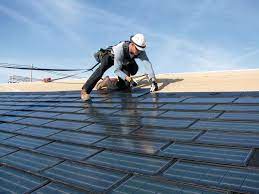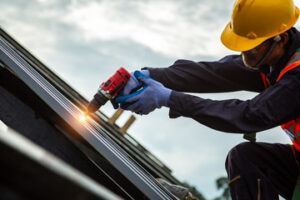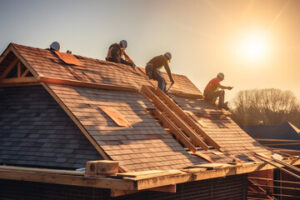A roof is one of the most important aspects of any home. Regular inspections and repairs keep it functioning properly and prevent damage to the rest of the structure.

Depending on the severity of damage, roofing professionals may repair or replace parts of your roof. They will also address underlying issues to future-proof your roof. Contact Roof Repair Riverview for professional help.
Shingles are your roof’s first line of defense against the elements. A damaged shingle weakens this protection, paving the way for moisture infiltration and those dreaded ceiling leaks. Early detection and intervention are crucial to prevent these issues from snowballing into major problems that require complete roof replacement.
Shingle damage is most commonly caused by weather exposure, which can lead to cracking, curling, and detachment from the roof. Other common causes include age, improper installation, and lack of regular maintenance.
Signs that you may have a shingle problem include water stains on the interior walls or ceiling, leaks, or increased energy bills. While these issues can be difficult to spot from the ground, a close inspection of your shingles can identify the source of the problem.
While a full roof replacement is often necessary in the event of severe damage, many small areas can be repaired with a partial repair. The good news is that you can do it yourself if you have the right tools and know-how.
Begin your roof repair by putting safety first and ensuring you have a stable ladder. Remove any debris that has fallen onto the shingles and carefully examine each shingle for signs of damage. For example, a missing shingle can allow water into the home, while a crack in the shingle exposes your roof to the sun’s harmful UV rays.
Start by loosening the shingle directly above the damaged one with a pry bar. If the nails are still in place, use a utility knife to cut around the nail heads and then pull off the old shingle.
Repeat this process for the shingles above, then replace the damaged shingle with a new, 3-tab shingle secured with 4 roofing nails. Sealant can be applied beneath the shingle to ensure it stays in place and camouflaged from view.
Curled shingles are a sign of aging and can be more susceptible to water damage and mold. If you notice them, replace the shingle with a new one.
Damaged Flashing
Flashing is a critical part of your roof, protecting areas of the house where surfaces intersect. It consists of metal plates, usually aluminum or galvanized steel, that cover the roof’s joints to prevent water from entering the house where it could cause extensive damage. You’ll see flashing near chimneys, pipes, openings in the roof, skylights, and other roof penetrations. Flashing is designed to be secured with roofing cement and sealed tightly into the surrounding shingles and other roof materials.
Damaged roof flashing can allow water to infiltrate the attic and walls of the home, causing wood rot, mold growth, and other structural issues. This can lead to costly repairs down the road and may even weaken the foundation of the home. To avoid these problems, homeowners should regularly inspect their roof and look for signs of flashing damage.
Common signs of roof flashing damage include leaks, visible gaps, rust, or missing sections. You should also look for discoloration and loose shingles. If you notice any of these signs, it’s important to call a professional roofing contractor right away.
Flashing can be repaired with a high-quality waterproof roof coating. This material is designed to expand and contract with the roof as it heats and cools, ensuring a durable seal. When applied correctly, this coating will extend the life of the flashing and protect the attic and walls from water damage.
Inspect the area of the roof with visible cracks or separation in the flashing, especially if it’s located around chimneys or other areas of the roof that experience frequent exposure to sunlight. The flashing should be cleaned thoroughly and then sealed with a high-quality, roof-compatible flashing sealant. A caulking gun or putty knife can be used to apply the sealant, which should be allowed to dry fully before a rain test is conducted.
You can also spot potential flashing damage by climbing up on your roof and carefully examining the areas where the flashing meets different surfaces. Use a ladder to safely climb to these areas, and be sure to wear rubber-soled shoes to protect your feet from sharp objects on the rooftop. You should also pay attention to any rust or holes in the flashing, as well as any areas that appear to be lifting or warping. These signs of damage can indicate that the flashing is no longer providing a secure seal and needs to be repaired immediately.
Damaged Gutters
Gutters that aren’t functioning properly cause serious problems. They’re supposed to channel rain and melted snow away from the house, but when they’re clogged or sagging, water seeps into fascia boards, soffits, and foundations. Eventually, this water will rot wood and damage the siding on your home. It can also seep into basements and lead to mold. If left unchecked, damaged gutters can lead to costly repairs and reduce the value of your home.
Over time, gutters can weaken or even pull away from the roof due to normal wear and tear. In addition, they can clog and become misaligned or pulled off by trees or other debris. Regardless of the cause, gutter problems must be repaired as soon as possible to avoid major leaks, foundation cracks, and landscape erosion.
Leaky gutters can cause significant damage to the roof, soffit and fascia, landscaping, and other components around your home. Most leaks are caused by holes or cracks, but they can also result from improper pitch, sagging, and loose hangers. While many of these problems can be repaired by homeowners, they’re best fixed by a professional to ensure safety and quality results.
The first step is to clean the gutters and identify leak locations. If the gutter is sagging, it may simply need to be raised by a few inches. To do this, you’ll need a ladder with a stable platform, and safety equipment like gloves and goggles. Next, you’ll need to mark the locations of the rafter tails on the fascia board and install new brackets that can be screwed through the gutter and into a rafter tail. Make sure to use heavy-duty gutter brackets that are rated for the weight of the gutter and the pitch of the system. Once you’ve reinstalled the new brackets, test the gutter with a hose to make sure it drains and doesn’t leak. You can also add additional brackets to reinforce weakened sections of the gutter. You should also check and tighten the screws that hold each bracket in place regularly to prevent sagging and ensure a secure fit.
Damaged Skylights
Skylights are a great addition to any home, allowing natural light into spaces that may otherwise be dark. However, like any roof feature, they’re not without their problems. In particular, they can leak or become damaged due to weather and age. The good news is, as long as homeowners take the time to inspect and maintain their skylights regularly, these windows can remain a valuable part of their home for years to come.
One of the most common signs of a leaky skylight is water stains on the ceiling or around the frame. If left unattended, this moisture can cause serious structural damage to your home and lead to costly repairs. Regular inspections by a roofing company can help you spot these issues early and prevent them from becoming larger problems.
Another sign that your skylight needs repair is the presence of a visible crack in its glass. Cracks can develop from impact or just from normal wear and tear, but they should be repaired immediately to prevent further damage.
Skylight leaks can also occur due to worn-out seals. These can be replaced relatively easily and inexpensively, but it’s important to have them properly installed to ensure a watertight seal. It’s also a good idea to check the weep holes on your skylight (these are intentional holes designed to allow moisture to drain out of the window) and make sure they are not clogged with debris or caulked shut by mistake.
Physical damage to your skylight can be more difficult to detect, but it’s still a key sign that the window needs repair. This can include cracks or discoloration of the glass and gaps in the skylight’s frame. These issues will decrease the amount of sunlight that can shine through the window and can increase your energy costs.
Skylights are a great way to add natural light to your home and can save you money on your utility bills. By knowing the signs of damage and identifying when to call in a professional for repairs, you can enjoy your skylight for years to come.


